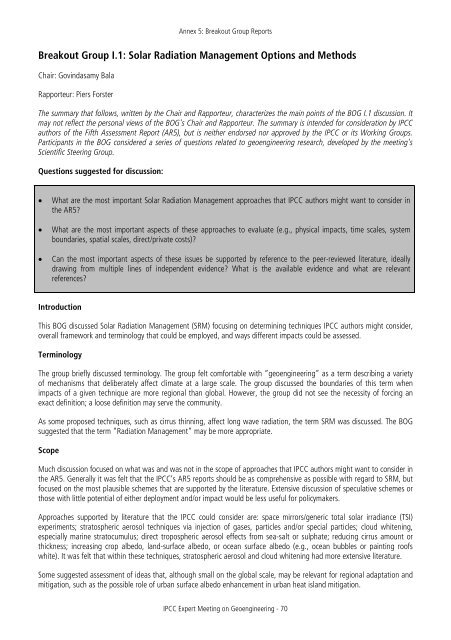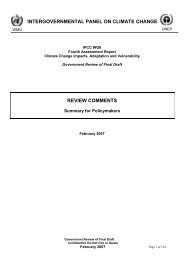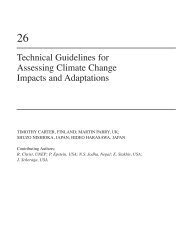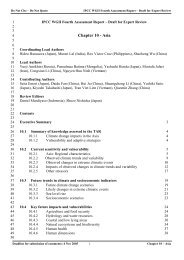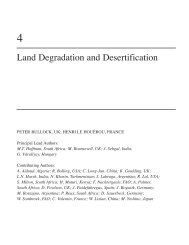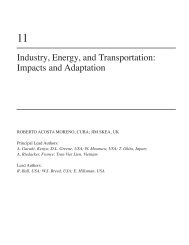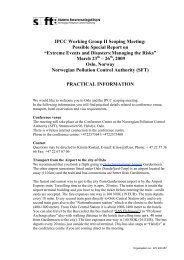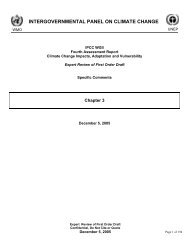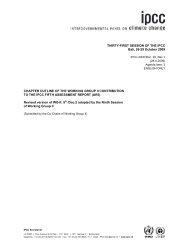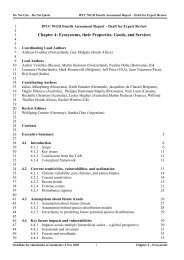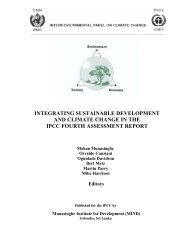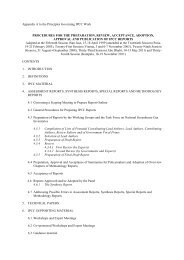IPCC Expert Meeting on Geoengineering
IPCC Expert Meeting on Geoengineering
IPCC Expert Meeting on Geoengineering
You also want an ePaper? Increase the reach of your titles
YUMPU automatically turns print PDFs into web optimized ePapers that Google loves.
Annex 5: Breakout Group Reports<br />
Breakout Group I.1: Solar Radiati<strong>on</strong> Management Opti<strong>on</strong>s and Methods<br />
Chair: Govindasamy Bala<br />
Rapporteur: Piers Forster<br />
The summary that follows, written by the Chair and Rapporteur, characterizes the main points of the BOG I.1 discussi<strong>on</strong>. It<br />
may not reflect the pers<strong>on</strong>al views of the BOG’s Chair and Rapporteur. The summary is intended for c<strong>on</strong>siderati<strong>on</strong> by <str<strong>on</strong>g>IPCC</str<strong>on</strong>g><br />
authors of the Fifth Assessment Report (AR5), but is neither endorsed nor approved by the <str<strong>on</strong>g>IPCC</str<strong>on</strong>g> or its Working Groups.<br />
Participants in the BOG c<strong>on</strong>sidered a series of questi<strong>on</strong>s related to geoengineering research, developed by the meeting’s<br />
Scientific Steering Group.<br />
Questi<strong>on</strong>s suggested for discussi<strong>on</strong>:<br />
<br />
<br />
<br />
What are the most important Solar Radiati<strong>on</strong> Management approaches that <str<strong>on</strong>g>IPCC</str<strong>on</strong>g> authors might want to c<strong>on</strong>sider in<br />
the AR5?<br />
What are the most important aspects of these approaches to evaluate (e.g., physical impacts, time scales, system<br />
boundaries, spatial scales, direct/private costs)?<br />
Can the most important aspects of these issues be supported by reference to the peer-reviewed literature, ideally<br />
drawing from multiple lines of independent evidence? What is the available evidence and what are relevant<br />
references?<br />
Introducti<strong>on</strong><br />
This BOG discussed Solar Radiati<strong>on</strong> Management (SRM) focusing <strong>on</strong> determining techniques <str<strong>on</strong>g>IPCC</str<strong>on</strong>g> authors might c<strong>on</strong>sider,<br />
overall framework and terminology that could be employed, and ways different impacts could be assessed.<br />
Terminology<br />
The group briefly discussed terminology. The group felt comfortable with “geoengineering” as a term describing a variety<br />
of mechanisms that deliberately affect climate at a large scale. The group discussed the boundaries of this term when<br />
impacts of a given technique are more regi<strong>on</strong>al than global. However, the group did not see the necessity of forcing an<br />
exact definiti<strong>on</strong>; a loose definiti<strong>on</strong> may serve the community.<br />
As some proposed techniques, such as cirrus thinning, affect l<strong>on</strong>g wave radiati<strong>on</strong>, the term SRM was discussed. The BOG<br />
suggested that the term “Radiati<strong>on</strong> Management” may be more appropriate.<br />
Scope<br />
Much discussi<strong>on</strong> focused <strong>on</strong> what was and was not in the scope of approaches that <str<strong>on</strong>g>IPCC</str<strong>on</strong>g> authors might want to c<strong>on</strong>sider in<br />
the AR5. Generally it was felt that the <str<strong>on</strong>g>IPCC</str<strong>on</strong>g>’s AR5 reports should be as comprehensive as possible with regard to SRM, but<br />
focused <strong>on</strong> the most plausible schemes that are supported by the literature. Extensive discussi<strong>on</strong> of speculative schemes or<br />
those with little potential of either deployment and/or impact would be less useful for policymakers.<br />
Approaches supported by literature that the <str<strong>on</strong>g>IPCC</str<strong>on</strong>g> could c<strong>on</strong>sider are: space mirrors/generic total solar irradiance (TSI)<br />
experiments; stratospheric aerosol techniques via injecti<strong>on</strong> of gases, particles and/or special particles; cloud whitening,<br />
especially marine stratocumulus; direct tropospheric aerosol effects from sea-salt or sulphate; reducing cirrus amount or<br />
thickness; increasing crop albedo, land-surface albedo, or ocean surface albedo (e.g., ocean bubbles or painting roofs<br />
white). It was felt that within these techniques, stratospheric aerosol and cloud whitening had more extensive literature.<br />
Some suggested assessment of ideas that, although small <strong>on</strong> the global scale, may be relevant for regi<strong>on</strong>al adaptati<strong>on</strong> and<br />
mitigati<strong>on</strong>, such as the possible role of urban surface albedo enhancement in urban heat island mitigati<strong>on</strong>.<br />
<str<strong>on</strong>g>IPCC</str<strong>on</strong>g> <str<strong>on</strong>g>Expert</str<strong>on</strong>g> <str<strong>on</strong>g>Meeting</str<strong>on</strong>g> <strong>on</strong> <strong>Geoengineering</strong> - 70


